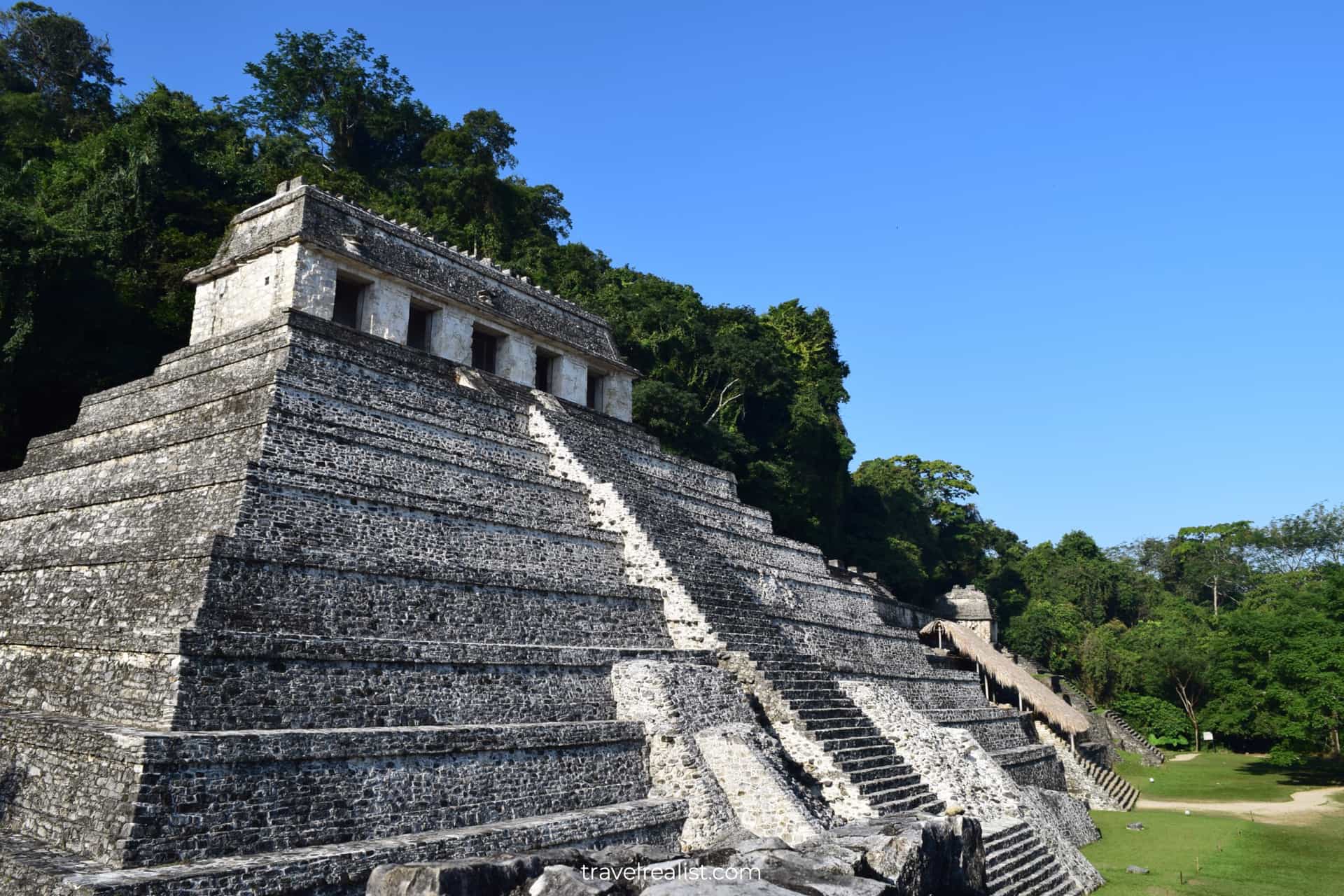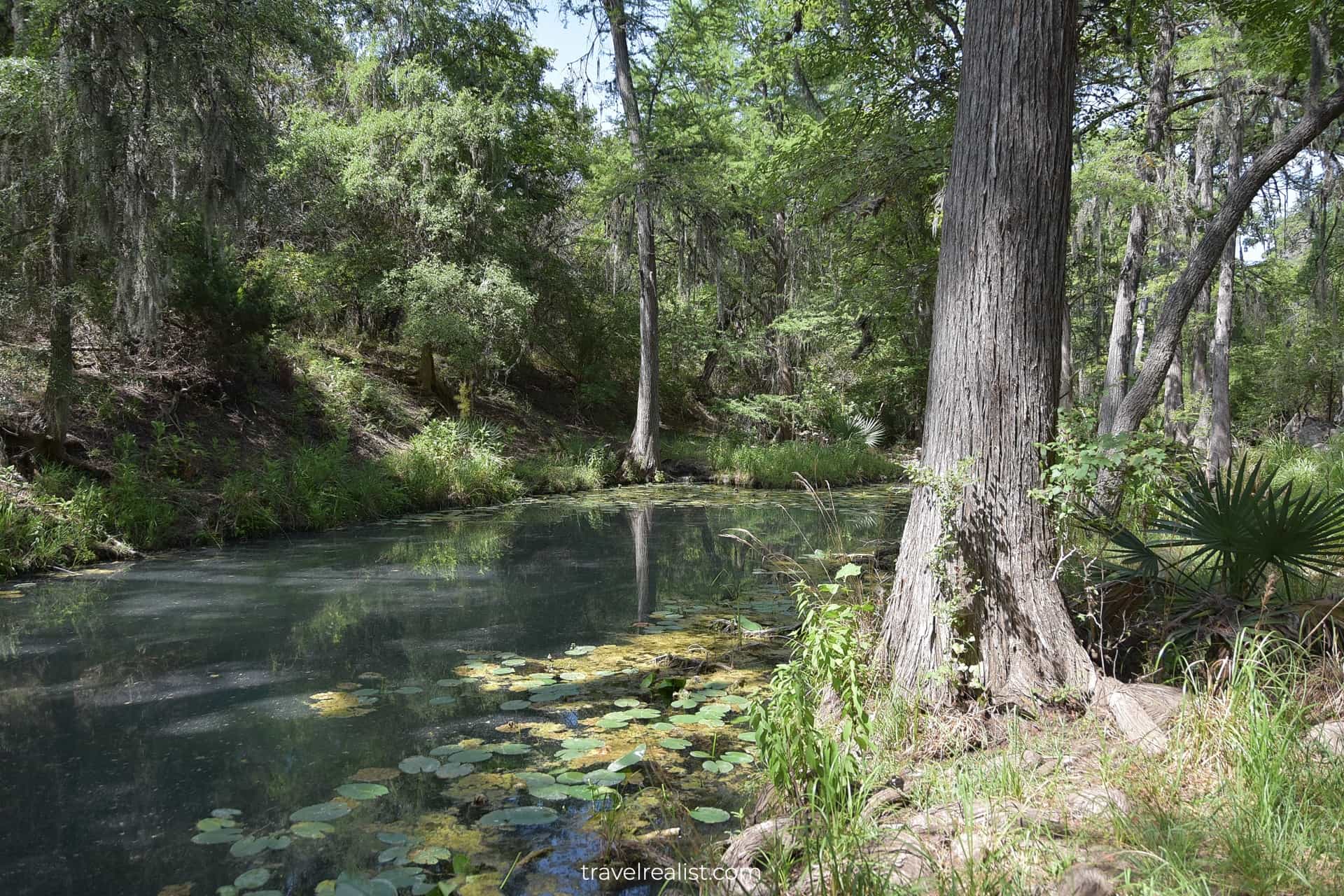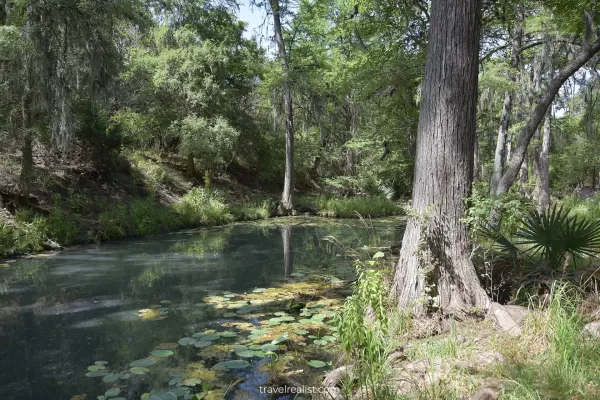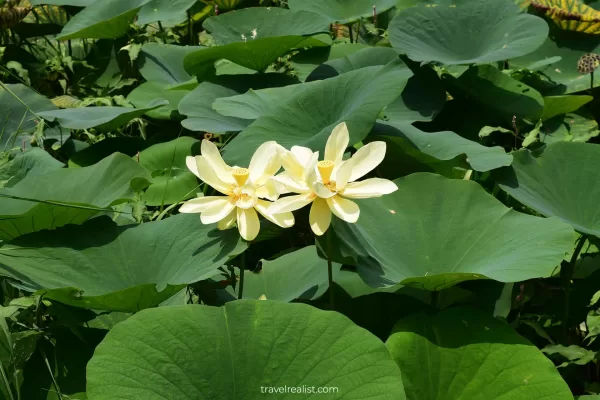Balcones Canyonlands: A Wildlife Refuge in Central Texas
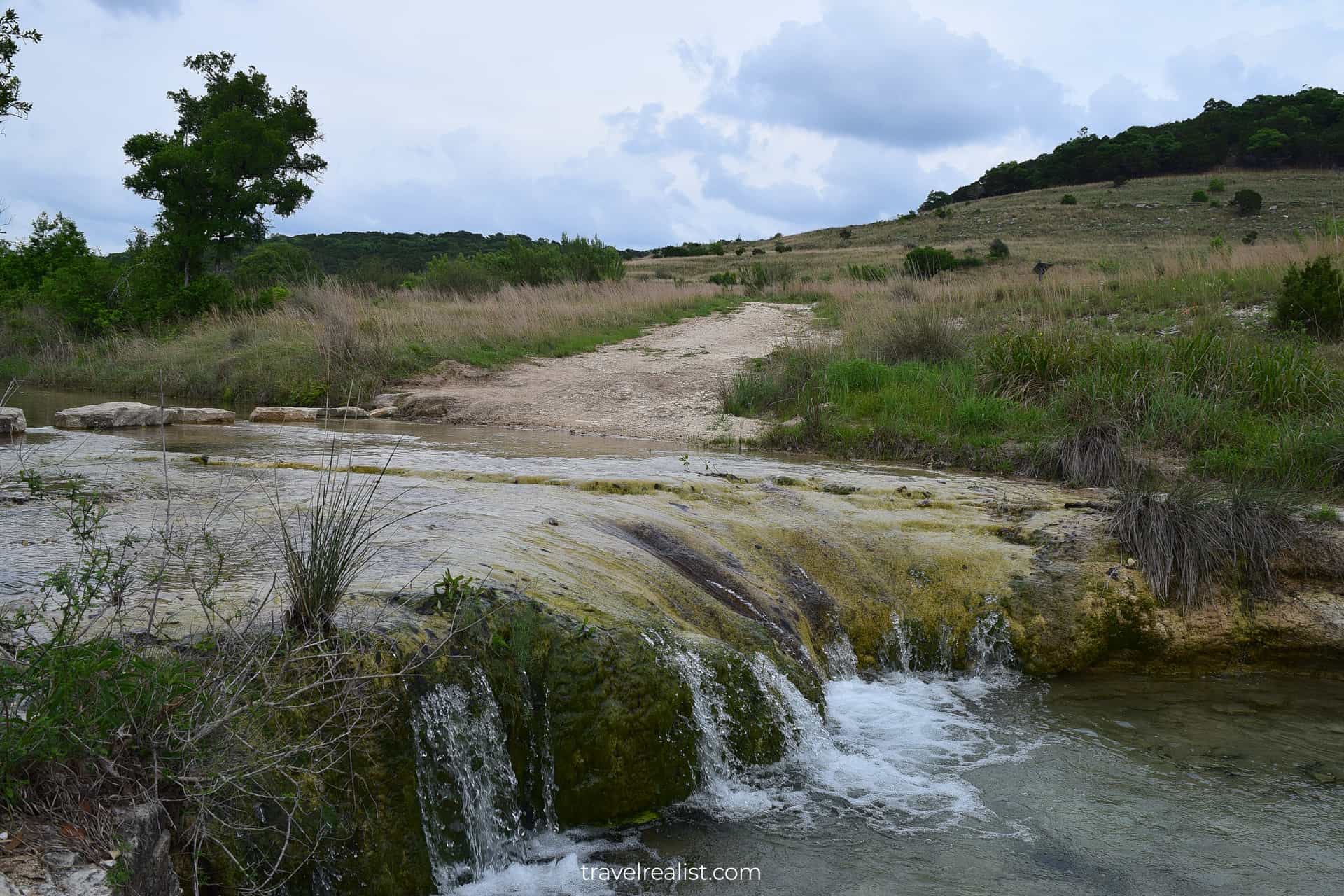
This realistic Balcones Canyonlands Visitor Guide helps you plan your next adventure in this wildlife refuge.
Balcones Canyonlands National Wildlife Refuge is a preserve in Central Texas. It protects the ecosystem of the Hill Country. Native birds like golden-cheeked warblers call Balcones Canyonlands home.
This post includes affiliate links that will earn us commission if you make a purchase via these links.
Sights & Places of Interest
Few people outside of Central Texas have heard about Balcones Canyonlands. In fact, it is common to confuse this preserve with a much more famous Canyonlands National Park in Utah.
This is hardly a surprise. Canyonlands in the Beehive State have beautiful red sandstone formations. National Park Service manages its scenic drive and a good number of hiking trails.
Balcones Canyonlands is a refuge in the Lone Star State. U.S. Fish and Wildlife Service maintains it to preserve native plants and wildlife. Recreation is a by-product for Balcones Canyonlands.
As a result, there is little information, short opening hours, and a few other restrictions. With so many other parks in the Hill Country, you need to make a real effort to visit Balcones Canyonlands.
Only three areas of the refuge open to public: Shin Oak Observation Deck, Doeskin Ranch, and Wabler Vista. This Balcones Canyonlands Visitor Guide covers things to do and see at all of them.
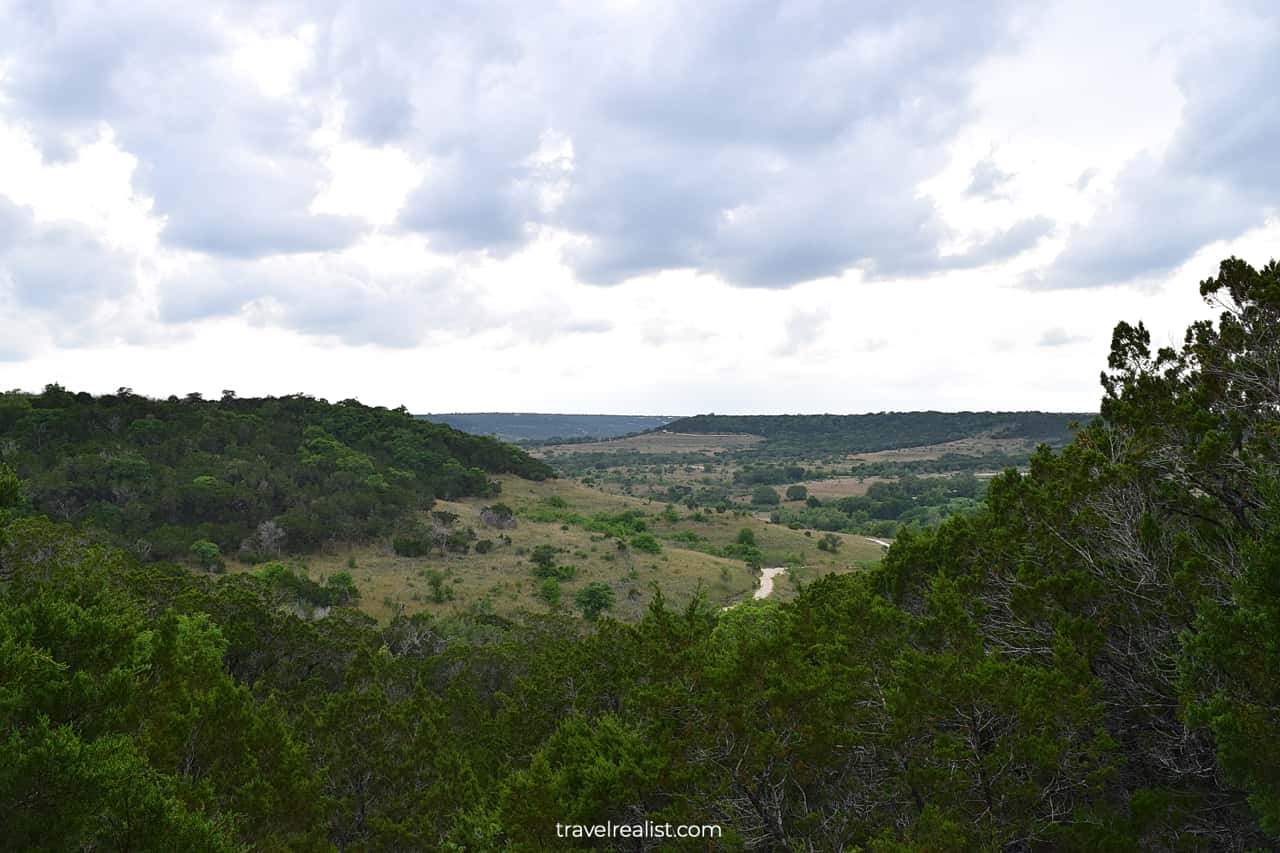
1. Shin Oak Observation Deck
Shin Oak Observation Deck is a great first stop in Balcones Canyonlands. It might be a little counterintuitive. This viewpoint is the northern most part of the park.
It should be easier to reach Warbler Vista and Doeskin Ranch. Both units are a good few miles (km) closer to Austin. But distance is only a part of the equation. Proximity to major roads also plays a role.
This is where Shin Oak Observation Deck wins over the other two units. It is has a better connection to Highways US-183 and TX-29 via Ranch to Market Road 1869.
While Shin Oak Observation Deck is the easiest unit to reach, it does not shine on other dimensions. In fact, you will likely spend the least time at this viewpoint.
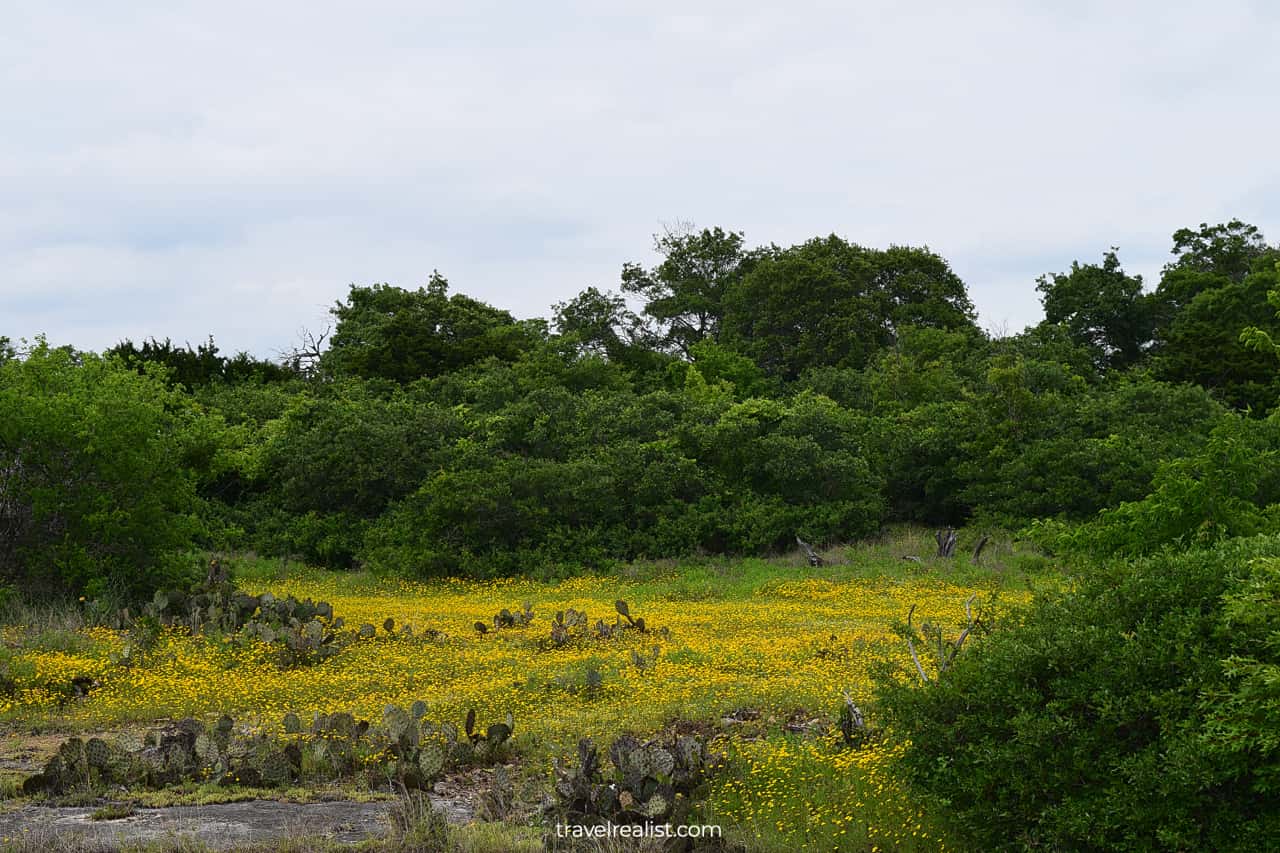
There is five-car parking lot and a short trail to a wooden pavilion. It is a bird watching spot. There are a few tips to follow to increase your changes of seeing birds.
You should arrive at the viewpoint at dawn or dusk. Animals tend to be more active during these hours. Bring binoculars or a spyglass to increase your field of vision.
The season also matters a lot. Fall and spring are better times than summer due to heat. You could also see a few migratory birds during the winter.
Yet, there is no guarantee that you will see birds even if you follow these tips by the book. Enjoy the blooming flowers and cacti next to the trail to make the trip worthwhile.
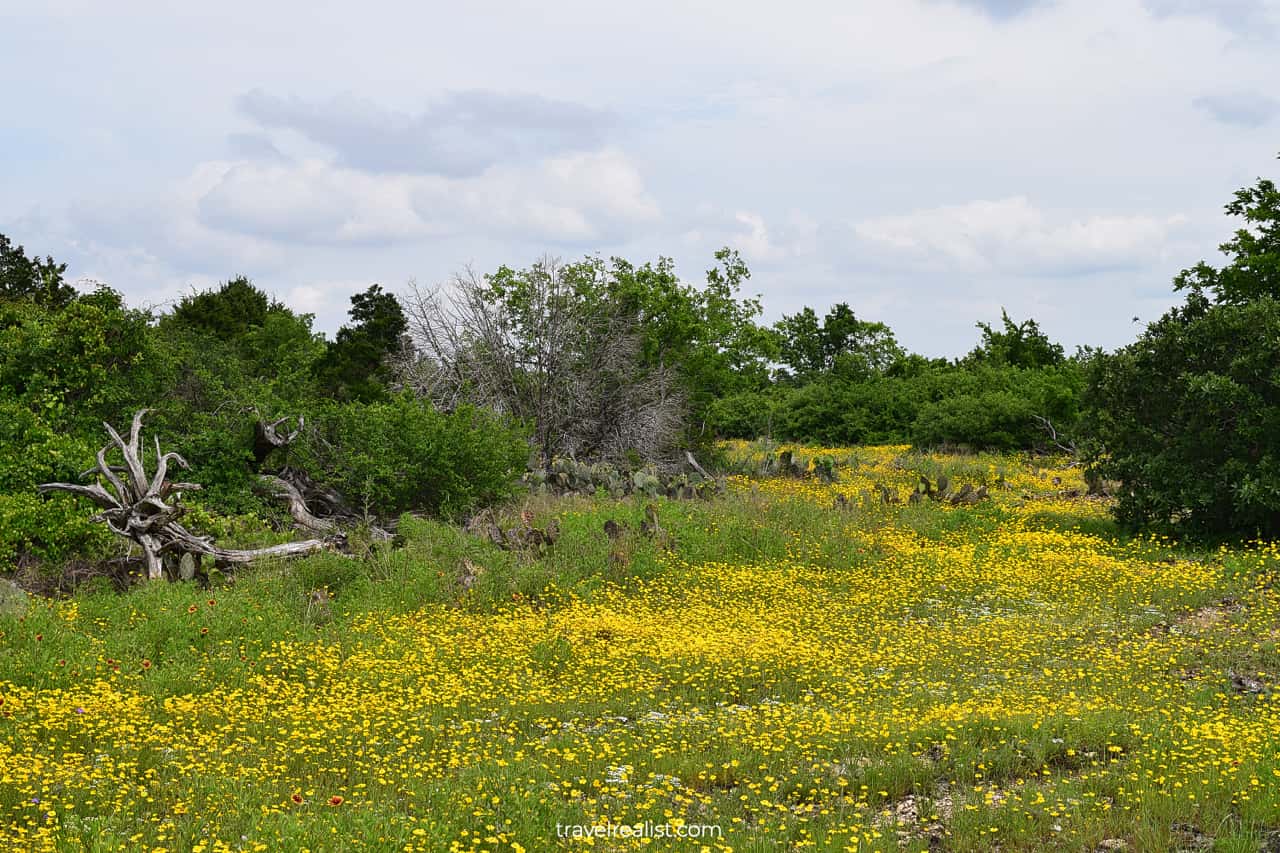
2. Doeskin Ranch
Once you finish wildlife watching at Shin Oak Observation Deck, hop back in the car. But do not get too comfortable. You should arrive at Doeskin Ranch in just 5 minutes.
This is the largest part of Balcones Canyonlands that is open to public. There are 4.7 miles (7.6 km) of hiking trails. They range from easy to challenging in difficulty.
Both beginner and advanced hikers could find a path that works for them. Keep in mind that most trail sections have little to no shade. Apply sunscreen, bring water, and wear a hat.
The next few sections of this Balcones Canyonlands Visitor Guide cover all 5 hiking trails at Doeskin Ranch. Read on to pick the right trail based on your fitness level and time in the preserve.
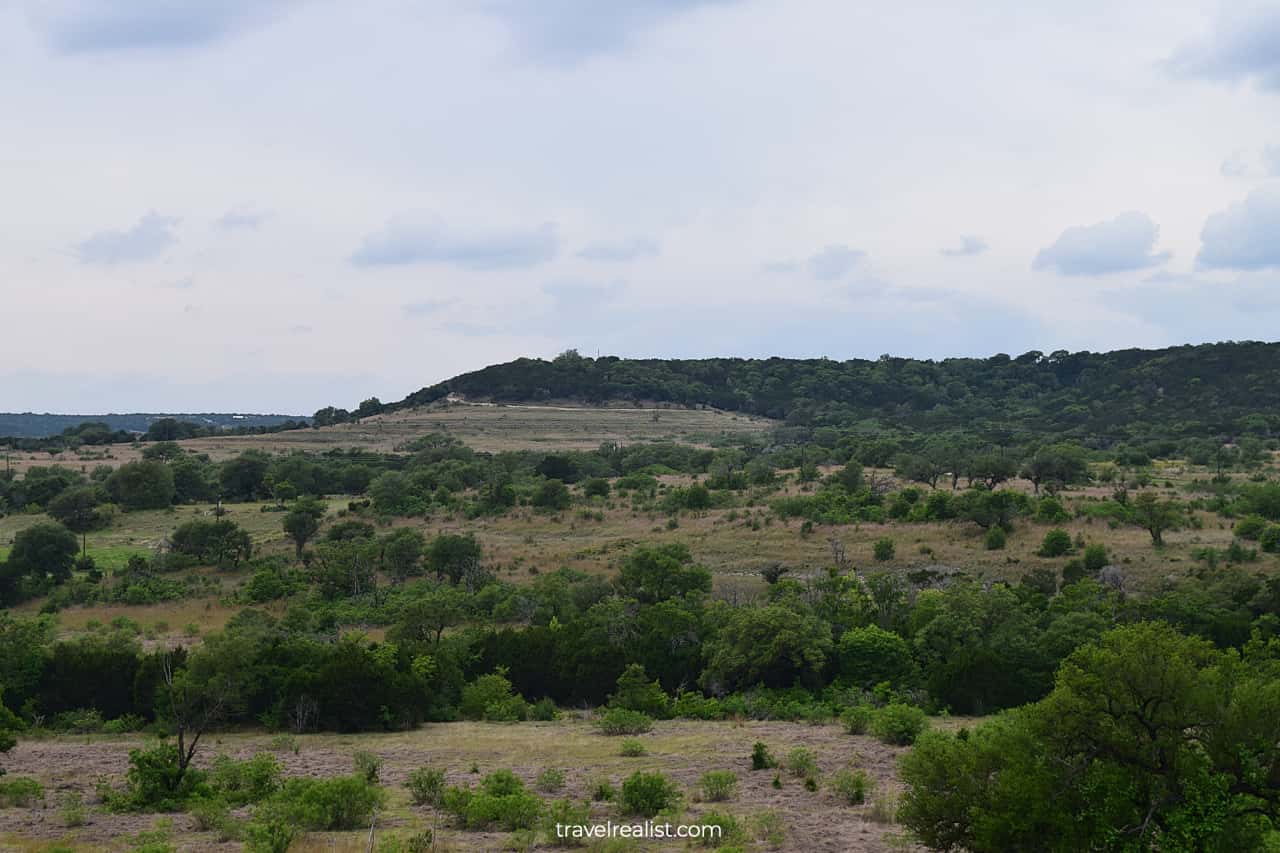
2.1. Pond and Prairie Trail
- Length: 0.5 mi (0.8 km)
- Type: Loop
- Difficulty: Easy
The Pond and Prairie Trail is the easiest path at Doeskin Ranch. It starts right from the parking lot.The only restroom at Doeskin Ranch is next to this trailhead.
As the name suggests, this paved path brings you to a pond along Road FM 1174. You will be hiking in a prairie with just a few trees. Do not play games with the sun in Texas. You will regret it on the next day.
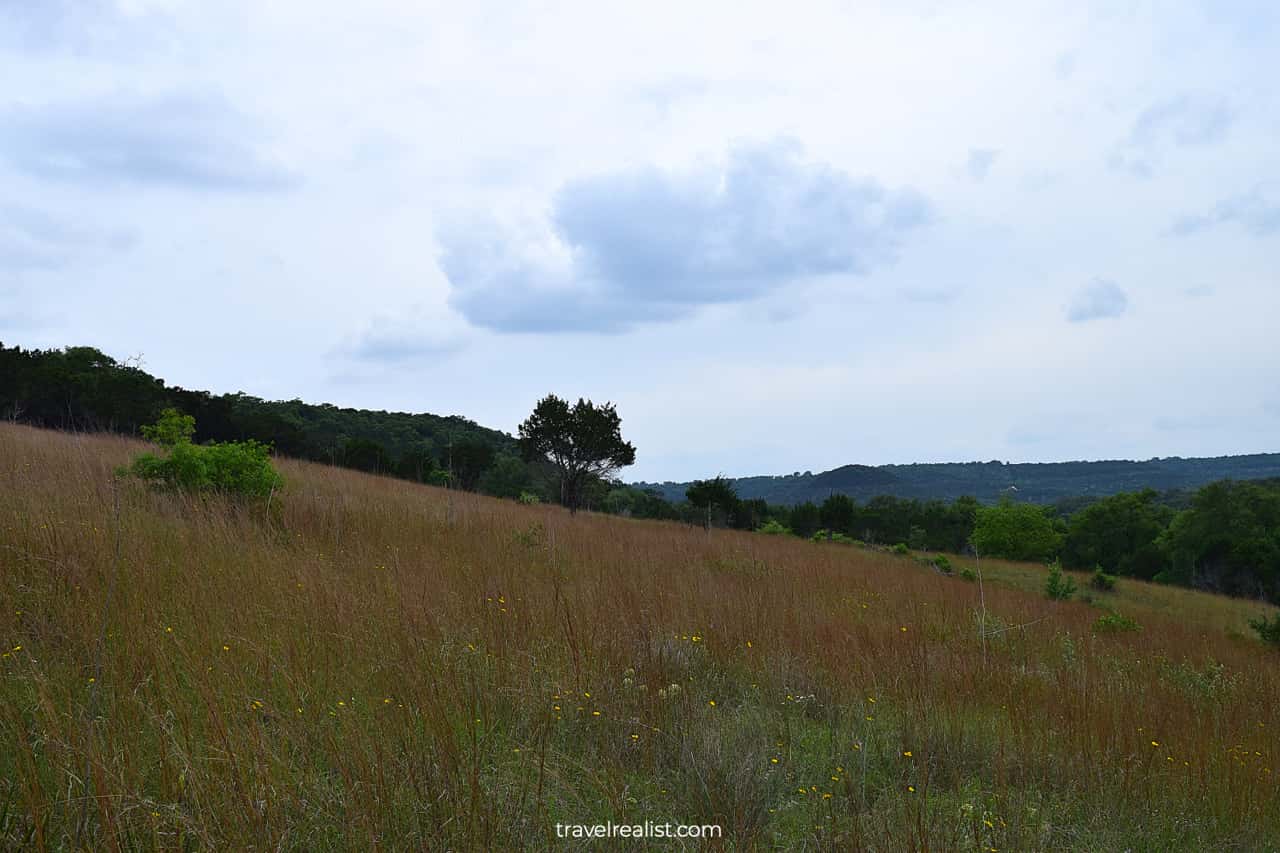
2.2. Creek Trail
- Length: 0.6 mi (1 km)
- Type: Loop
- Difficulty: Easy
The Creek Trail is slightly longer than the Pond and Prairie Trail. But it is also an easy path that involves just 67 ft (20 m) in elevation gain.
This trail follows a creek before arriving at the other side of the parking lot. A few of the trail sections are a narrow dirt path. The rest is a paved or gravel path.
The Creek Trail has more shade thanks to moisture. Get ready to hike through a few groves and wooded areas. But do not drop your hat too soon. There are a fair number of prairies on this trail.
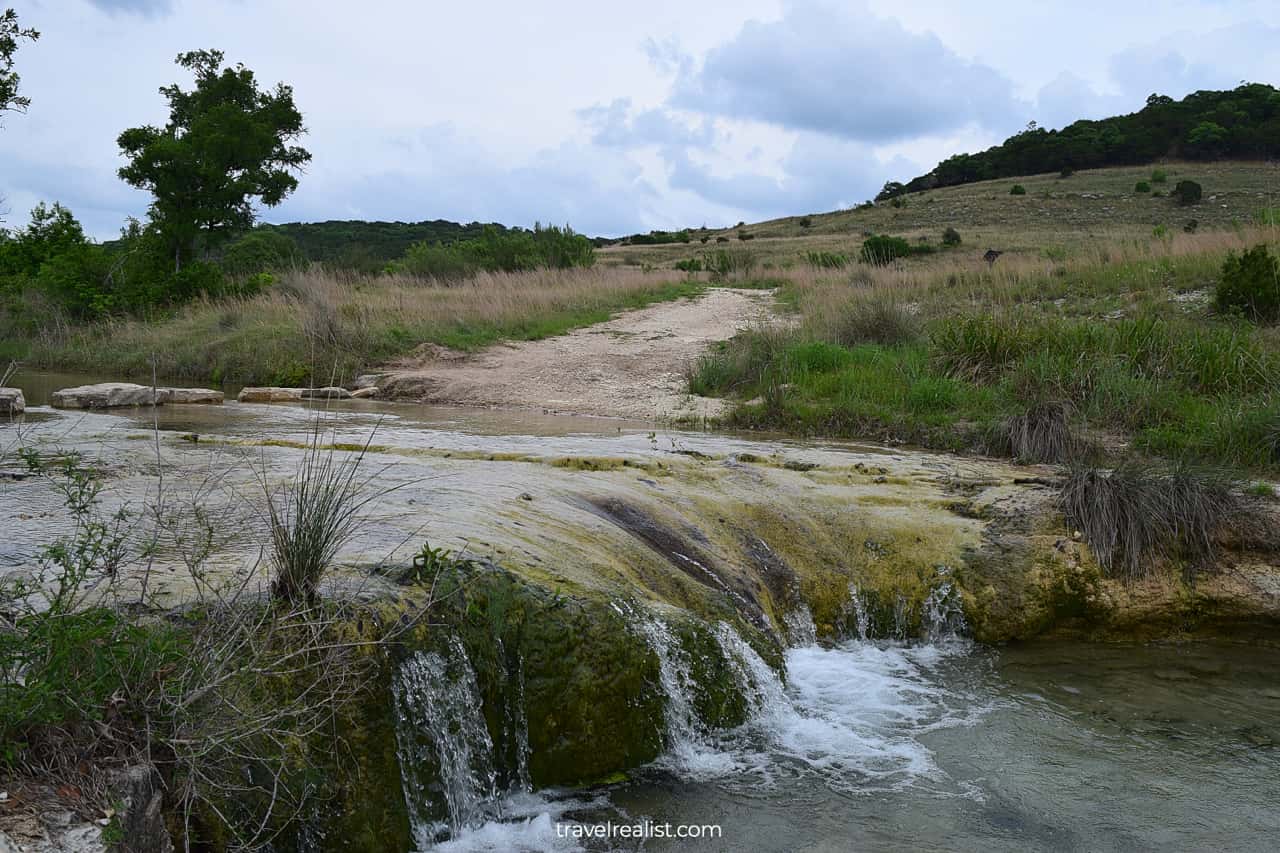
2.3. Rimrock Trail
- Length: 1.6 mi (2.5 km)
- Type: Loop
- Difficulty: Difficult
There is one more easy trail at Doeskin Ranch. But to reach this trail and other routes, you need to hike the challenging Rimrock Trail first. This trail is longer than both Pond and Prairie and Creek Trails.
But it is not the distance that makes it challenging. You need to gain 298 ft in elevation (90 m) as you hike to the top of the hill.
The direction does not make a difference when hiking the Rimrock Trail. But if you prefer to reach the top sooner, hike it counterclockwise.
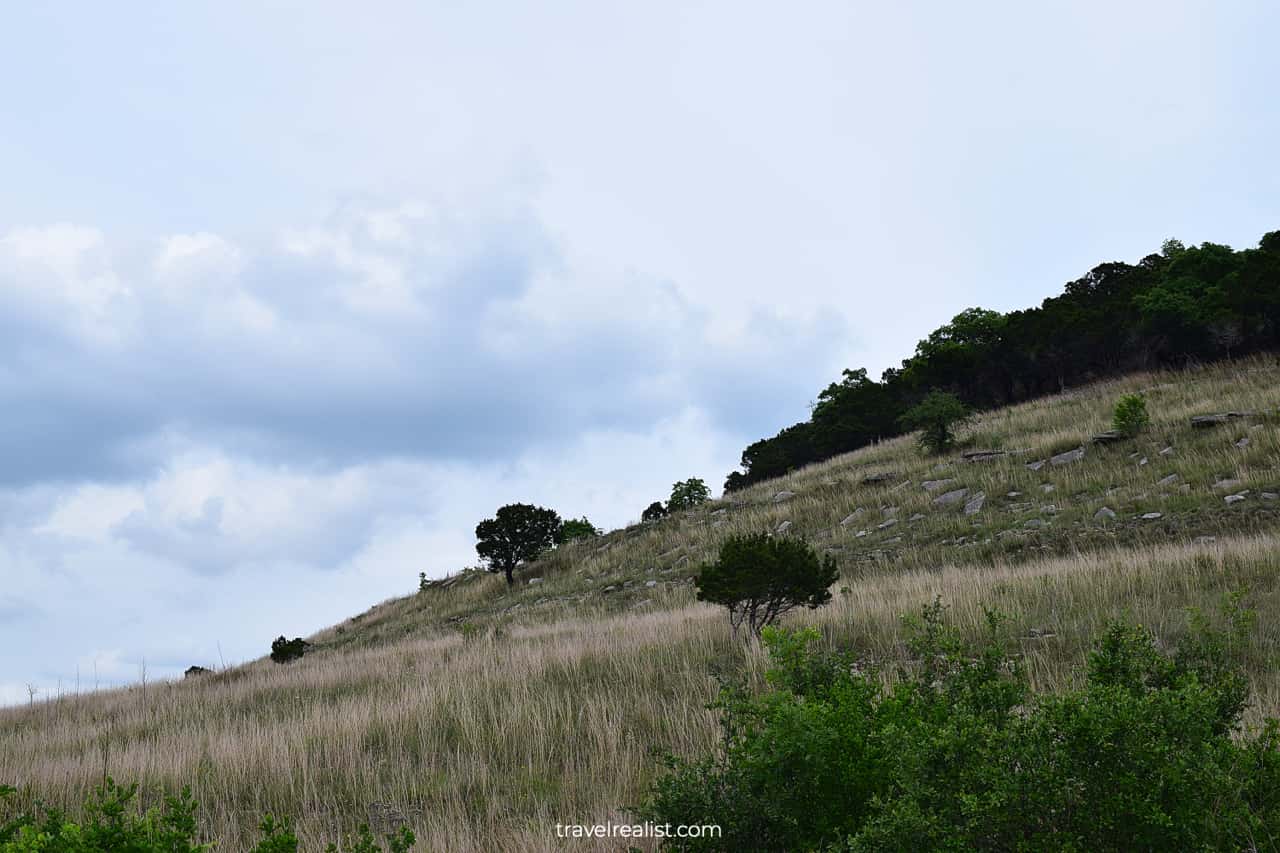
A moderately strenuous uphill hike is the first section of this trail. You will cross the prairie and enter a cedar grove. It provides a much needed shade.
Know your limits as you hike uphill. Pace yourself and take breaks to catch your breath. You would not want to tire yourself out on this section. Slow and steady wins the race.
The Rimrock trail flattens out once you reach the plateau. You need to turn left if you plan on hiking just this path. You will start the downhill hike just 0.3 miles (0.5 km) after finishing the ascend.
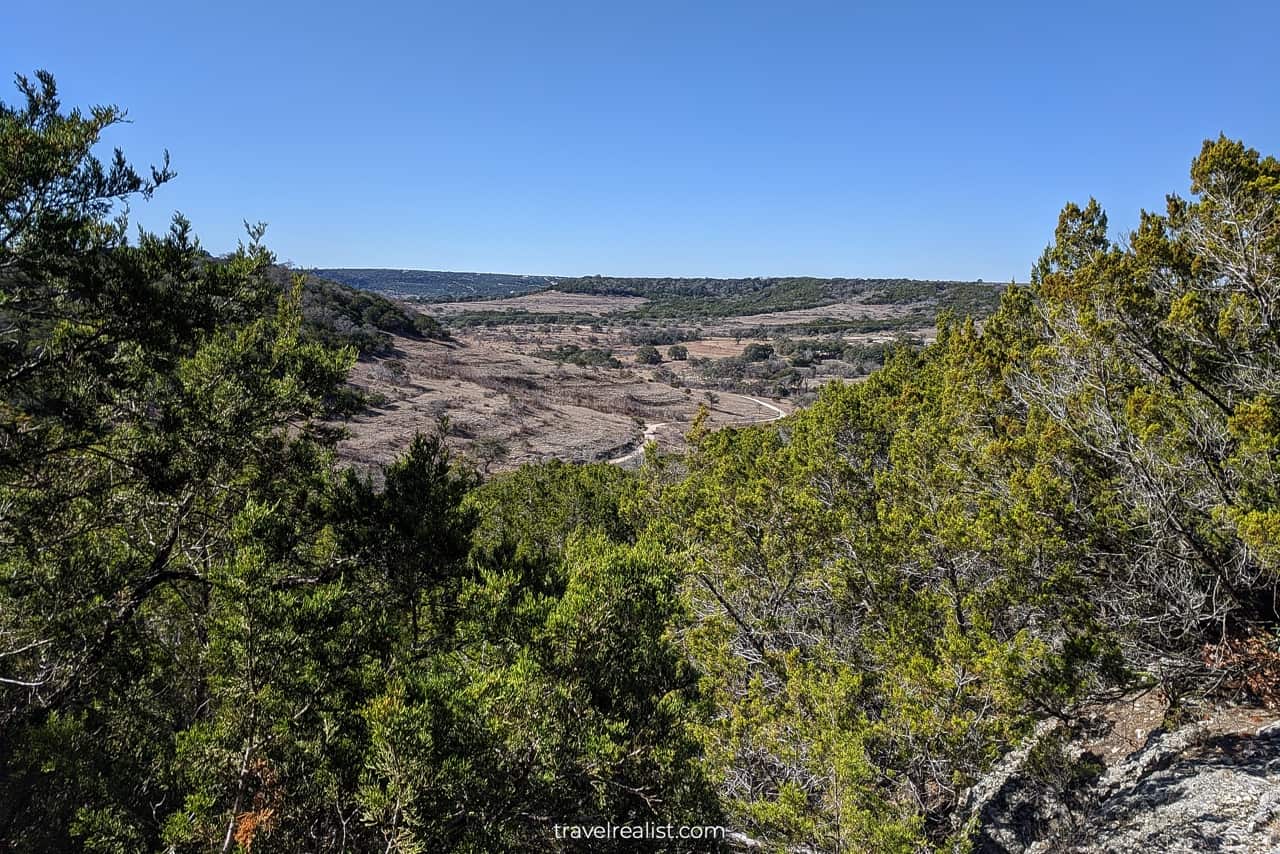
2.4. Shin Oak Trail
- Length: 0.5 mi (0.8 km)
- Type: Out-and-back
- Difficulty: Easy
The Shin Oak Trail gives you an easy way to extend your hiking adventure at Doeskin Ranch. This trail looks a lot more like an unpaved country road than a trail.
You will be hiking in a field of blooming cacti and flowers if you visit the preserve in the spring. Yellow flowers and green grass are the main attraction on the Shin Oak Trail.
The path is next to the groves. But there is not a single part of this trail that has shade. It might be a good idea to finish it quickly before taking the last trail at this park unit.
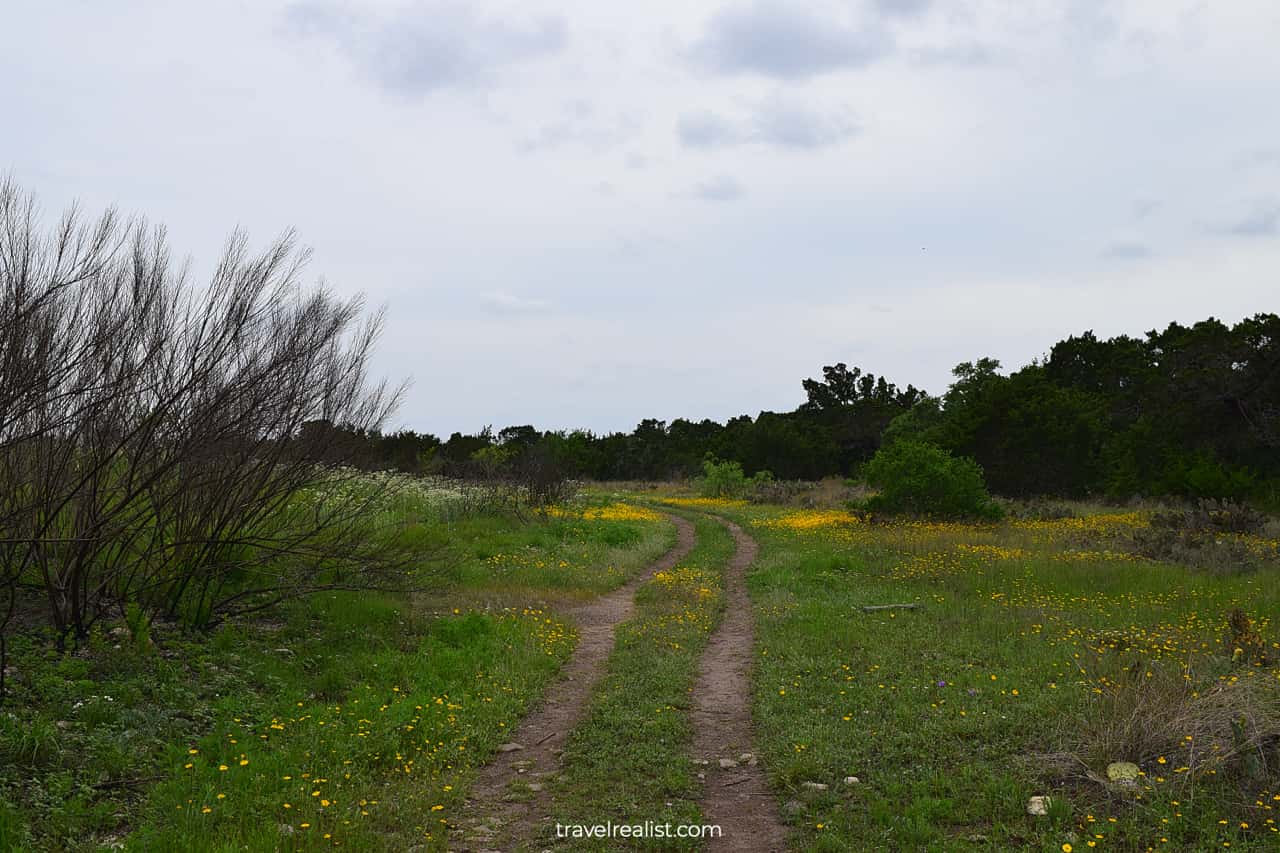
2.5. Indiangrass Trail
- Length: 1.5 mi (2.4 km)
- Type: Out-and-back
- Difficulty: Moderate
The Indiangrass Trail brings you the furthest into Balcones Canyonlands. This trail starts and finishes at the Shin Oak Trail. You need to hike sections of the Rimrock and Shin Oak Trails to get to the trailhead.
This setup is quite similar to Williamson Creek Overlook Trail in McKinney Falls State Park. Jones Spring Trail in Pedernales Falls follows a similar pattern.
You will hike a total of 3.6 miles (5.8 km) if you decide to take the Indiangrass Trail. The total elevation gain is a respectable 528 ft (161 m). This is higher than summiting Enchanted Rock.
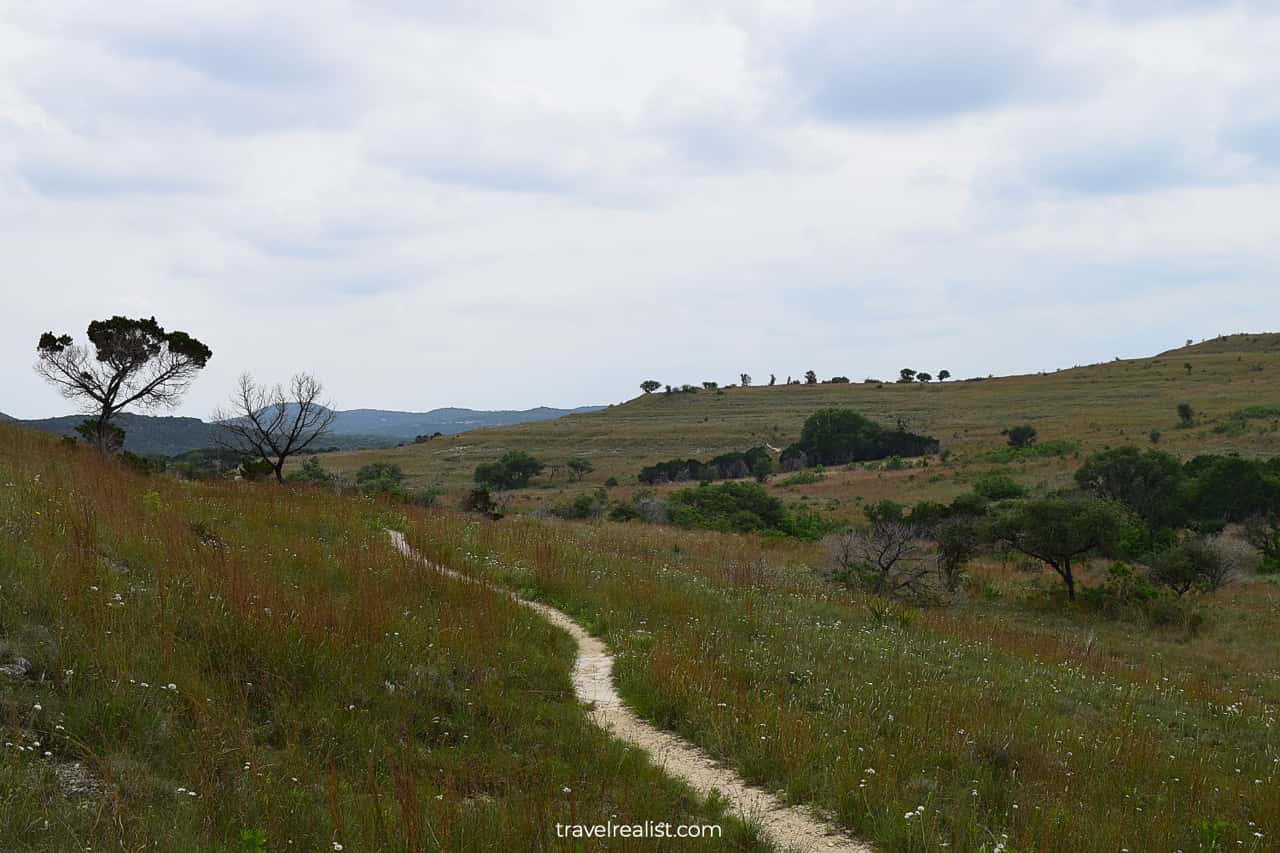
The Indian Grass Trail starts with a gradual descend from the plateau and the Shin Oak Trail. The trail then becomes a flat and narrow path.
It goes through the fields with beautiful grasses, flowers, and plants. This trail puts the natural beauty of Central Texas on full display.
As you hike through the prairie, you should expect little shade. But this area does not have any at all after a prescribed burn a few years ago. It will take this landscape a few years to regain its strength.
Until that happens, you might be better off finishing the Oak Shin Trail loop. You will return to the Rimrock Trail, cross the creek, and arrive at the parking lot.
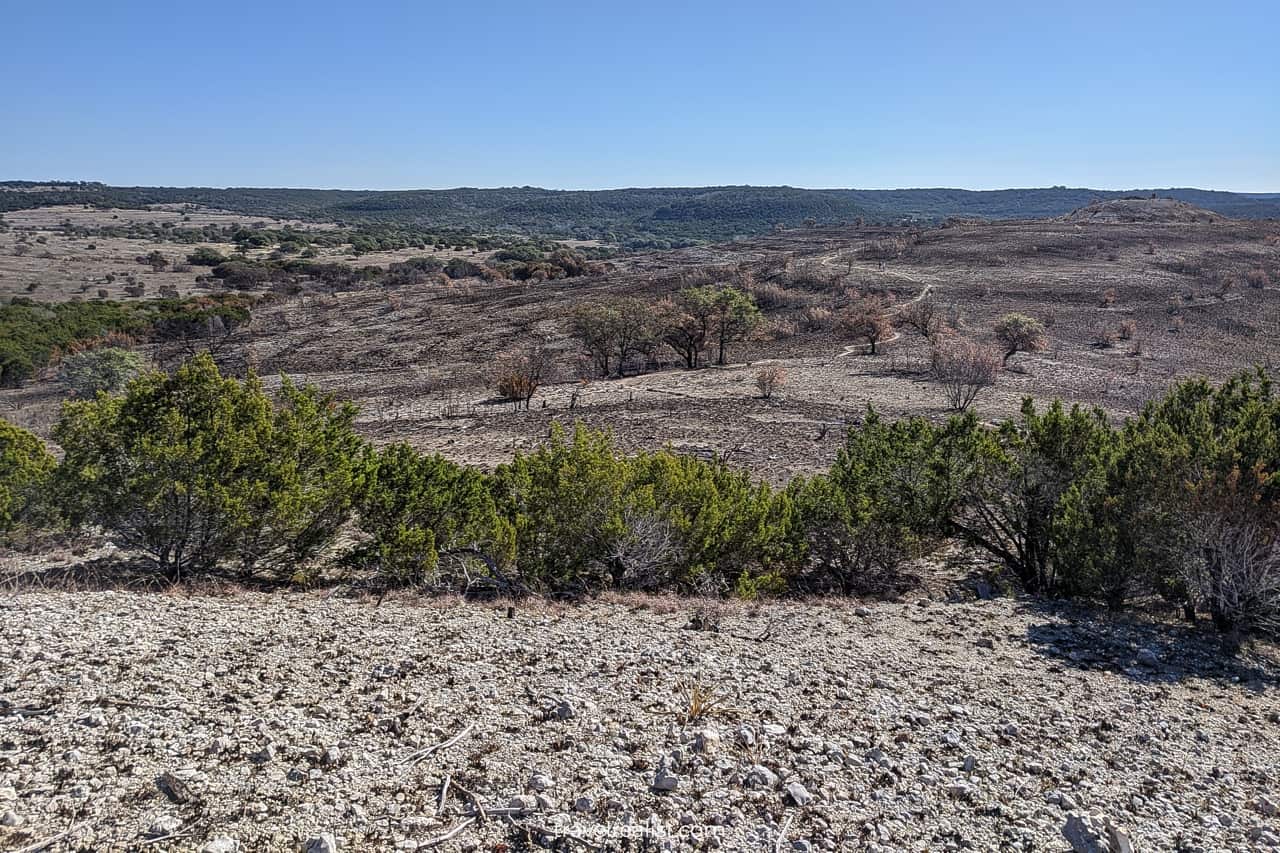
3. Headquarters
A long and challenging hike at Doeskin Ranch could tire down even the experienced hikers. But there are more places to see in the preserve if you have time and strength.
It is a good idea to start driving towards Warbler Vista unit next. Get ready for a 30-minute drive from Doeskin Ranch. You will arrive at the Visitor Information Center a few miles west of Warbler Vista first.
You could choose to stop there if you visit on a weekday. Outside of the ranger station, there are two easy hiking trails.
- Post Oak Trail: a 0.4-mi (0.6-km) loop to a photo blind.
- Pollinator Path: a 0.2-mi (0.3-km) out-and-back path.
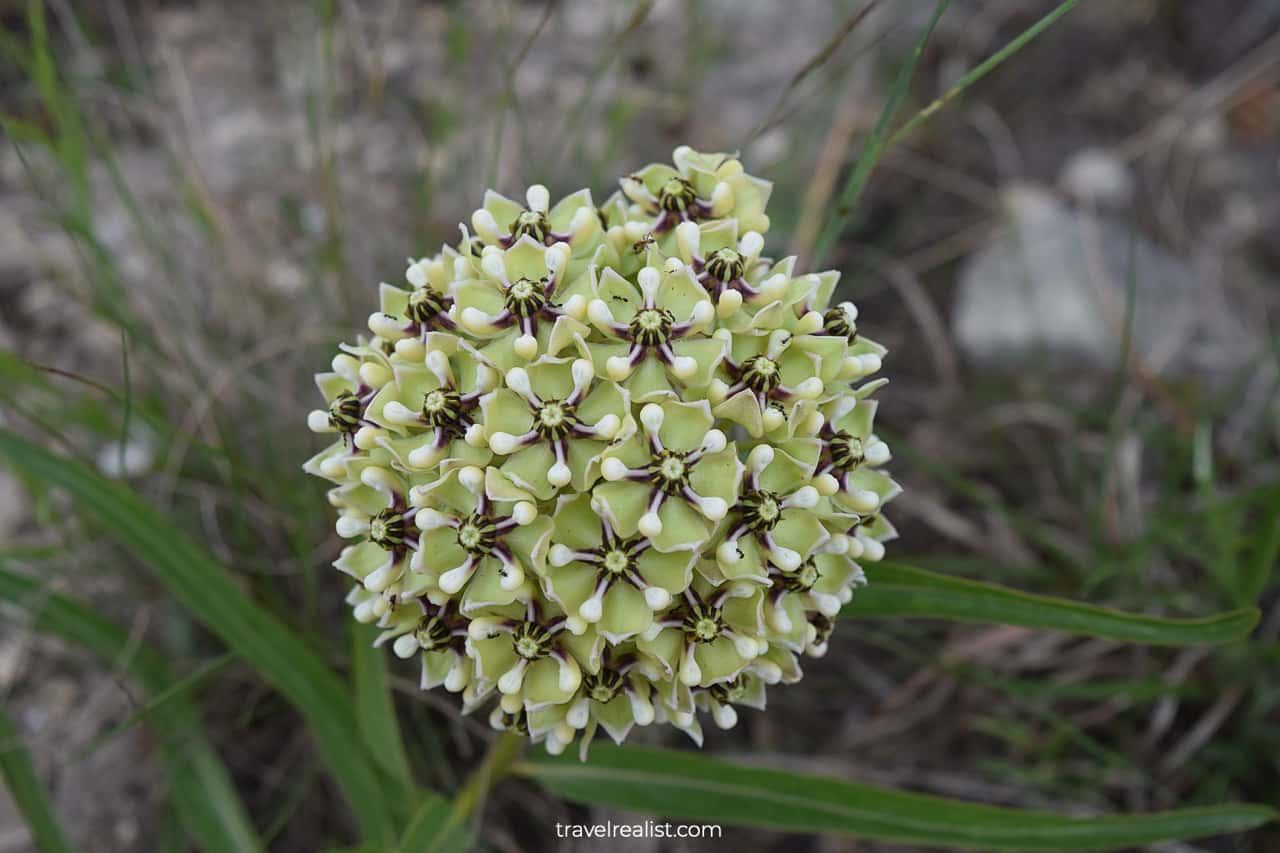
4. Warbler Vista
The hiking trails near the Headquarters pale in comparison to the trails at Doeskin Ranch and Warbler Vista. The last unit of Balcones Canyonlands is a better place to visit.
Plus, most of the preserve visitors come to Balcones Canyonlands on the weekends and holidays. The Visitor Information Center trails are not open at that time.
The last mile (1.6 km) to Warbler Vista is on an unpaved gravel road. Unless you have a high clearance car, drive slowly to avoid a puncture.
4.1. Sunset Deck
The Sunset Deck makes the drive on an unsealed road worth the risk. You need to take a few steps from your car to get an amazing panorama.
This observation deck offers great views of Lake Travis on the Colorado River. You could even see Pace Bed Park on the other bank.
The name of this viewpoint does not lie. The views are even better if you visit the observation deck around the sunset. Enjoy the amazing colors over the Texas Hill Country as the sun sets.
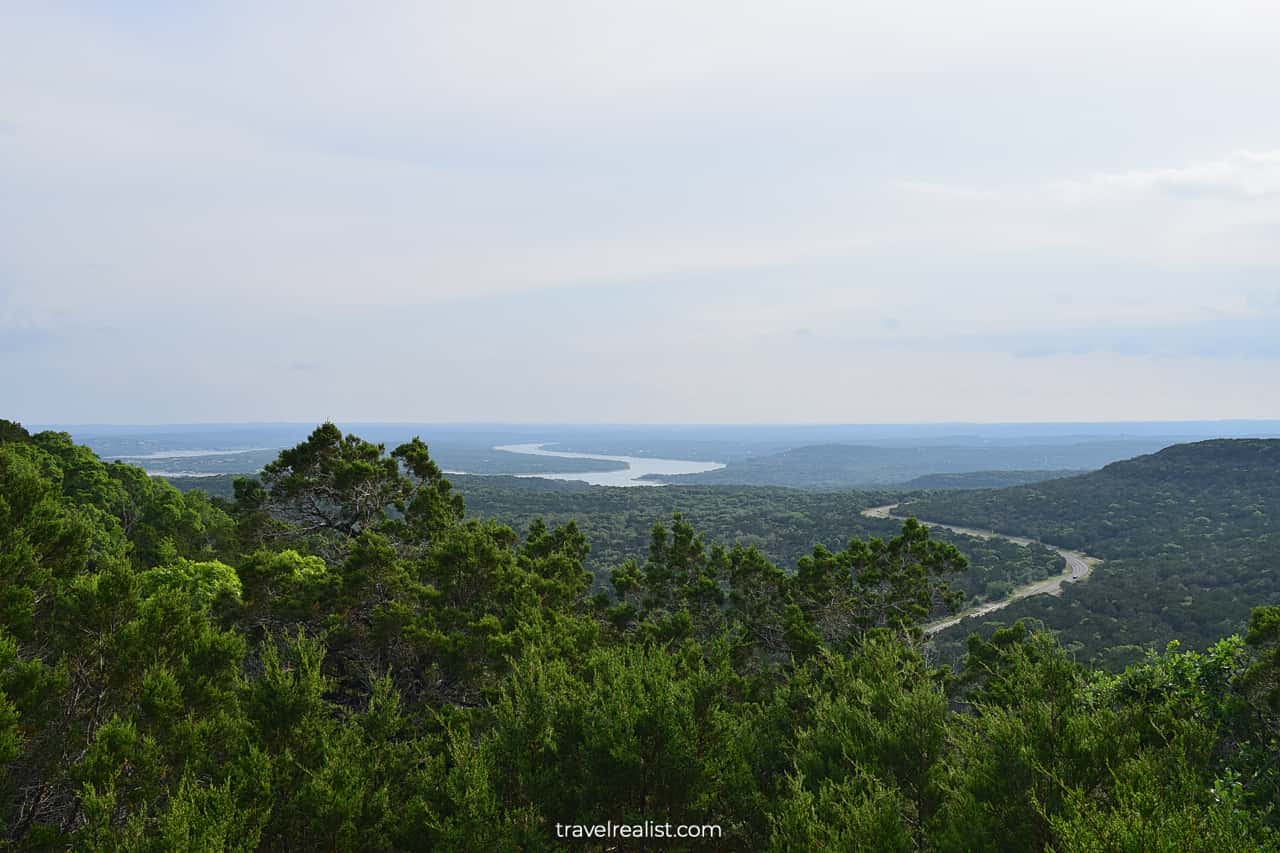
4.2. Ridgeline Trail
- Length: 1.2 mi (1.9 km)
- Type: Out-and-back
- Difficulty: Moderate
There are also ways to explore Warbler Vista on a hiking trail. The Ridgeline Trail is a gateway to this park unit. It starts next to the Sunset Deck.
This path mostly follows the ridge. As a result, there is little elevation change at the beginning. As you go further towards the Vista Knoll Trail, it starts to lose elevation.
Unless you have a self driving car, you need to hike uphill on the way back. Keep an eye on birds and other wildlife as you hike the Ridgeline Trail.
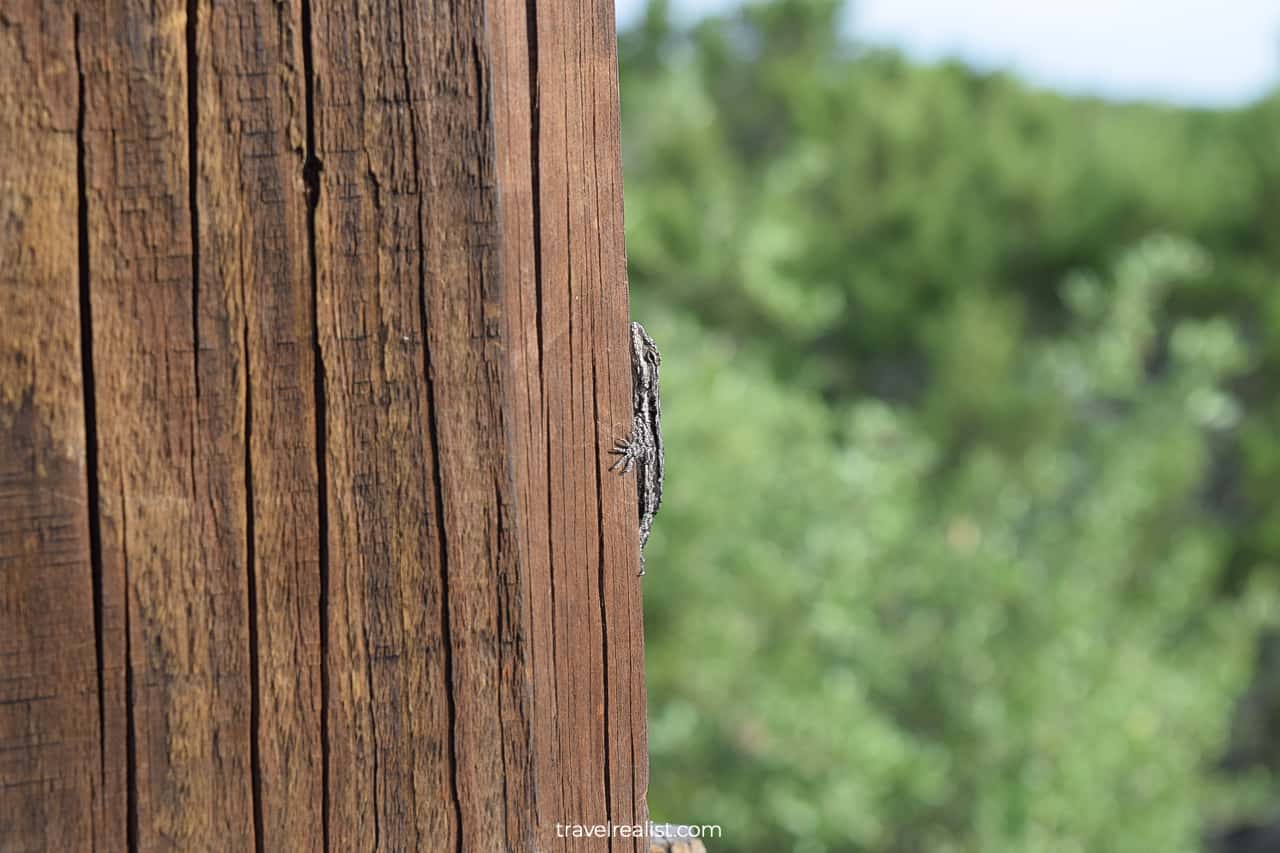
4.3. Vista Knoll Trail
- Length: 0.5 mi (0.8 km)
- Type: Loop
- Difficulty: Moderate
The Vista Knoll Trail is an obvious continuation of the Ridgeline Trail. This path has some elevation gain as you cross over the ridge.
You should take this trail to get great views of the surrounding Hill Country. Enjoy a slightly clearer view of Lake Travis than from the Sunset Deck.
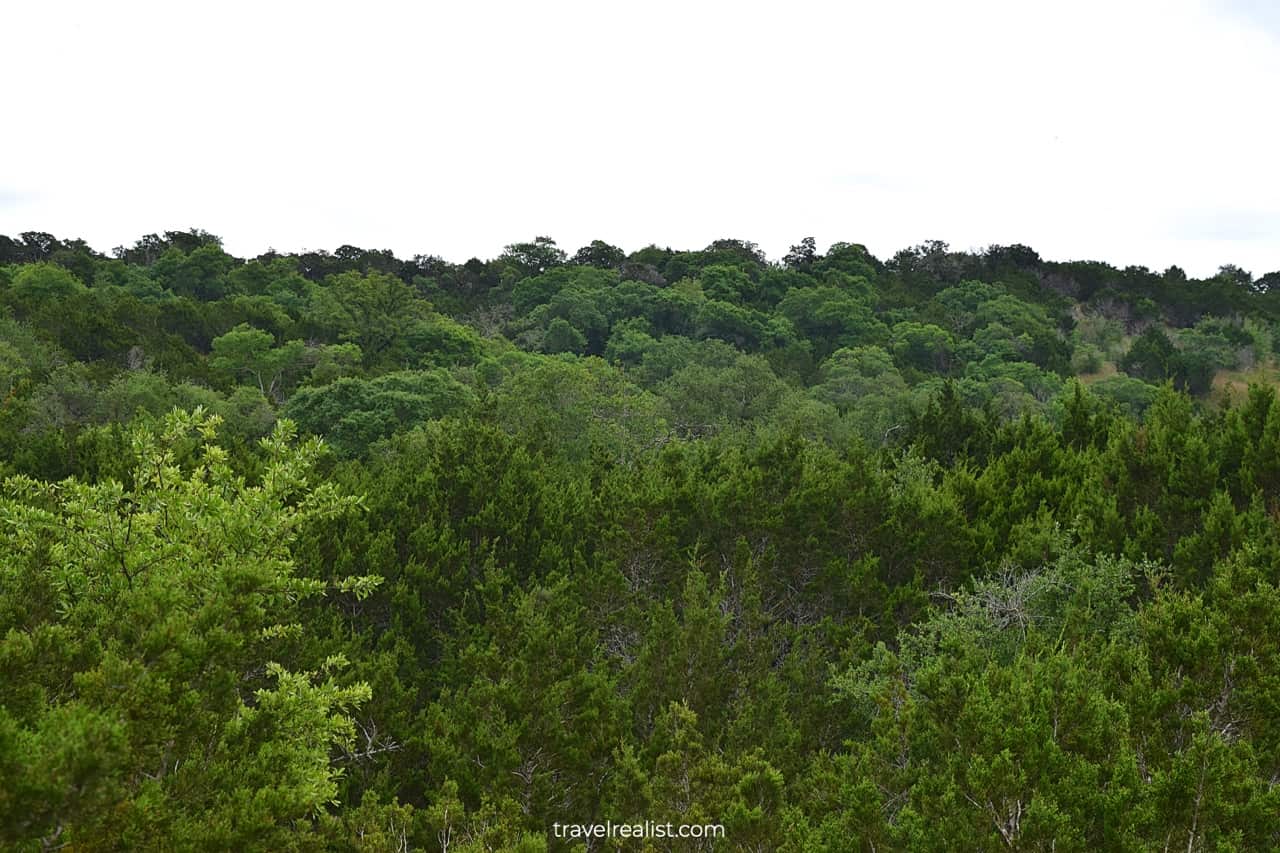
4.4. Cactus Rocks Trail
- Length: 1.25 mi (2 km)
- Type: Loop
- Difficulty: Moderate
The Cactus Rocks Trail is the longest path at Warbler Vista. This trail continues along the ridge line. It helps keep the elevation gain to 98 ft (30 m).
Like the Ridgeline Trail, it is an excellent place to see birds and other wildlife. You might even spot a golden-cheeked warbler if you hike between March and July.
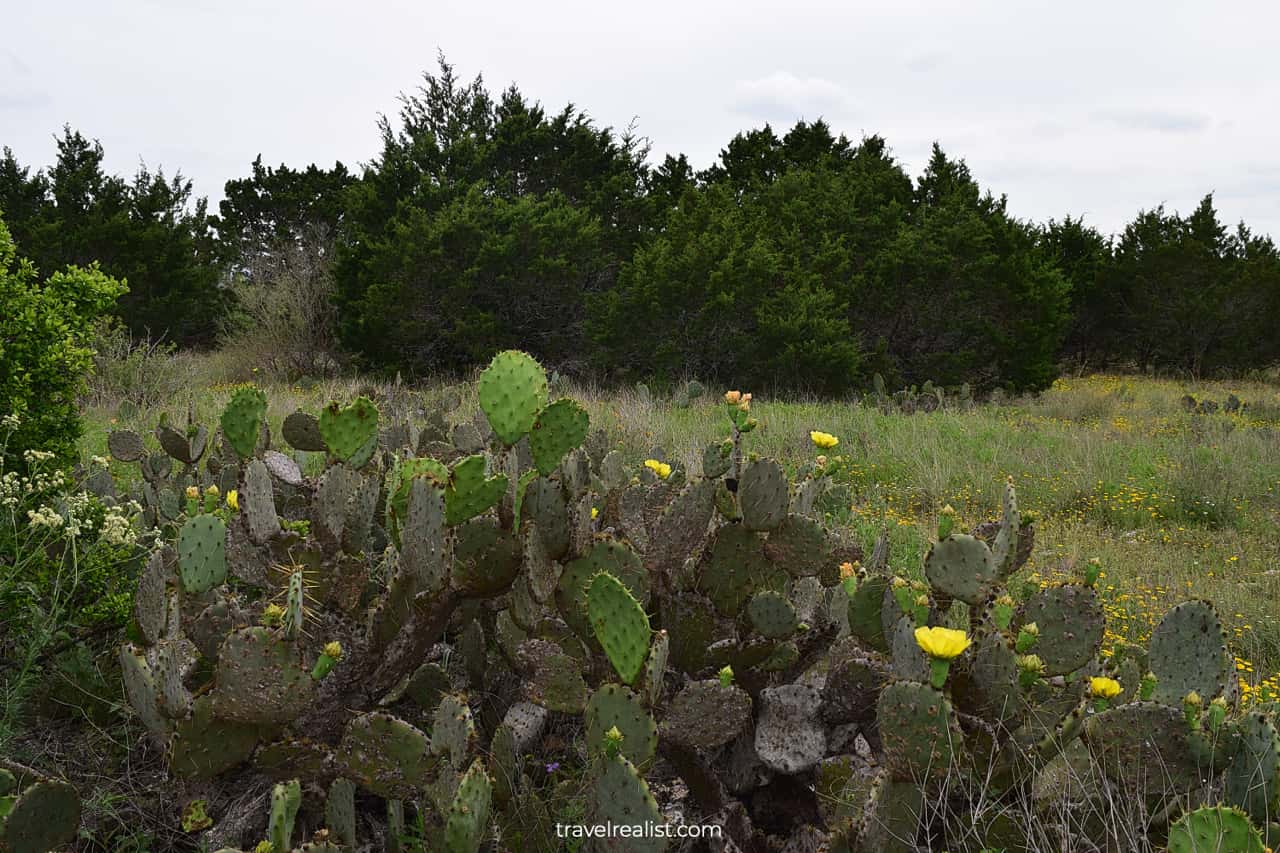
4.4. Boulder Trail
- Length: 0.4 mi (0.6 km)
- Type: Out-and-back
- Difficulty: Difficult
You could choose to return to the Sunset Deck after a finishing the Cactus Rock Trail Loop. But there is another trail to consider. The Boulder Trail is a connector that brings you downhill to Quarry Canyon.
The steep descend might not present you with too many challenges. But do not forget to plan a return journey. Otherwise, you would need to regain all of the lost elevation on your way back.
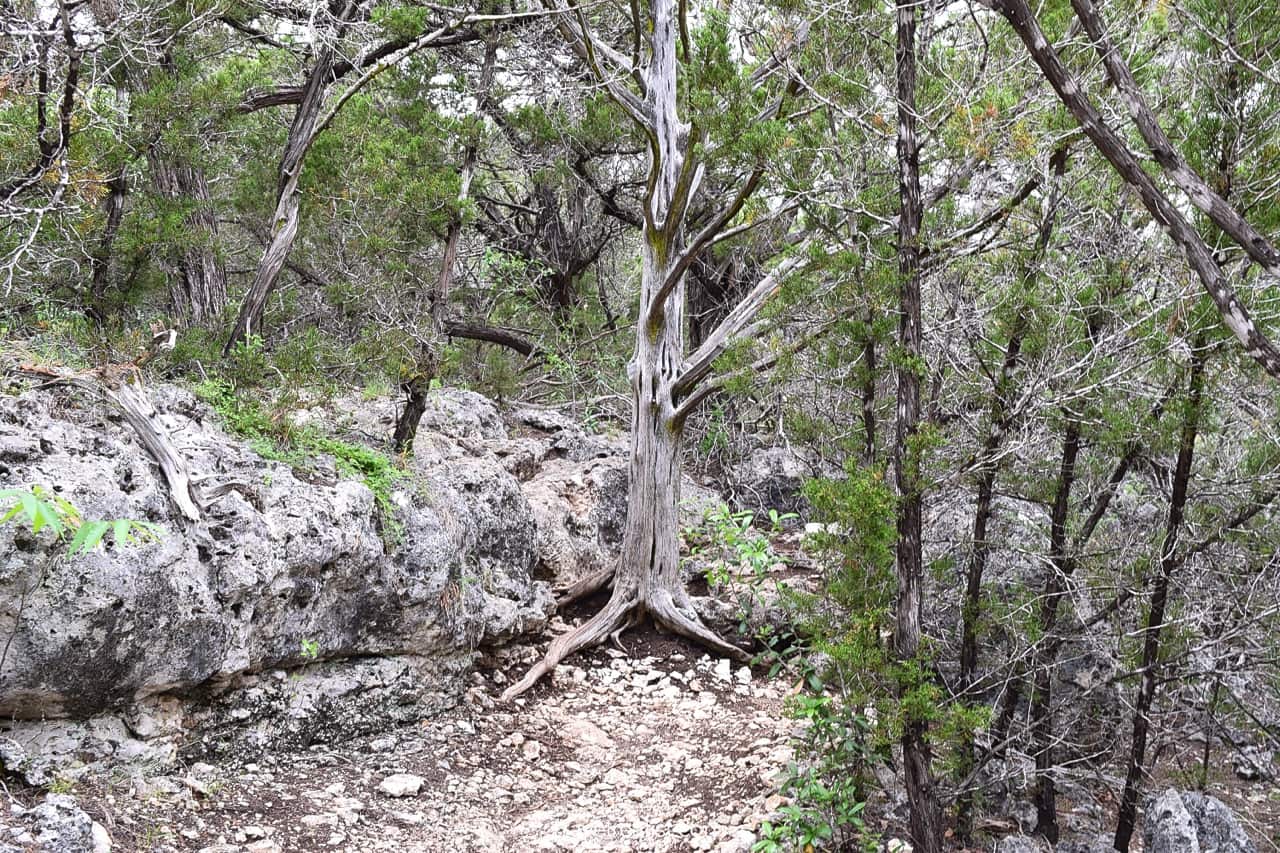
4.6. Quarry Canyon Trail
- Length: 0.6 mi (1 km)
- Type: Out-and-back
- Difficulty: Difficult
The Quarry Canyon Trail is the most difficult trail at Warbler Vista. This is due to a sizable elevation gain. This path connects the Vista Knoll Trail with the lower parking lot.
There are only two good reasons to take this trail. The first reason has to do with you trying to challenge yourself. The second reason is to not risk your car by sticking to the paved roads.
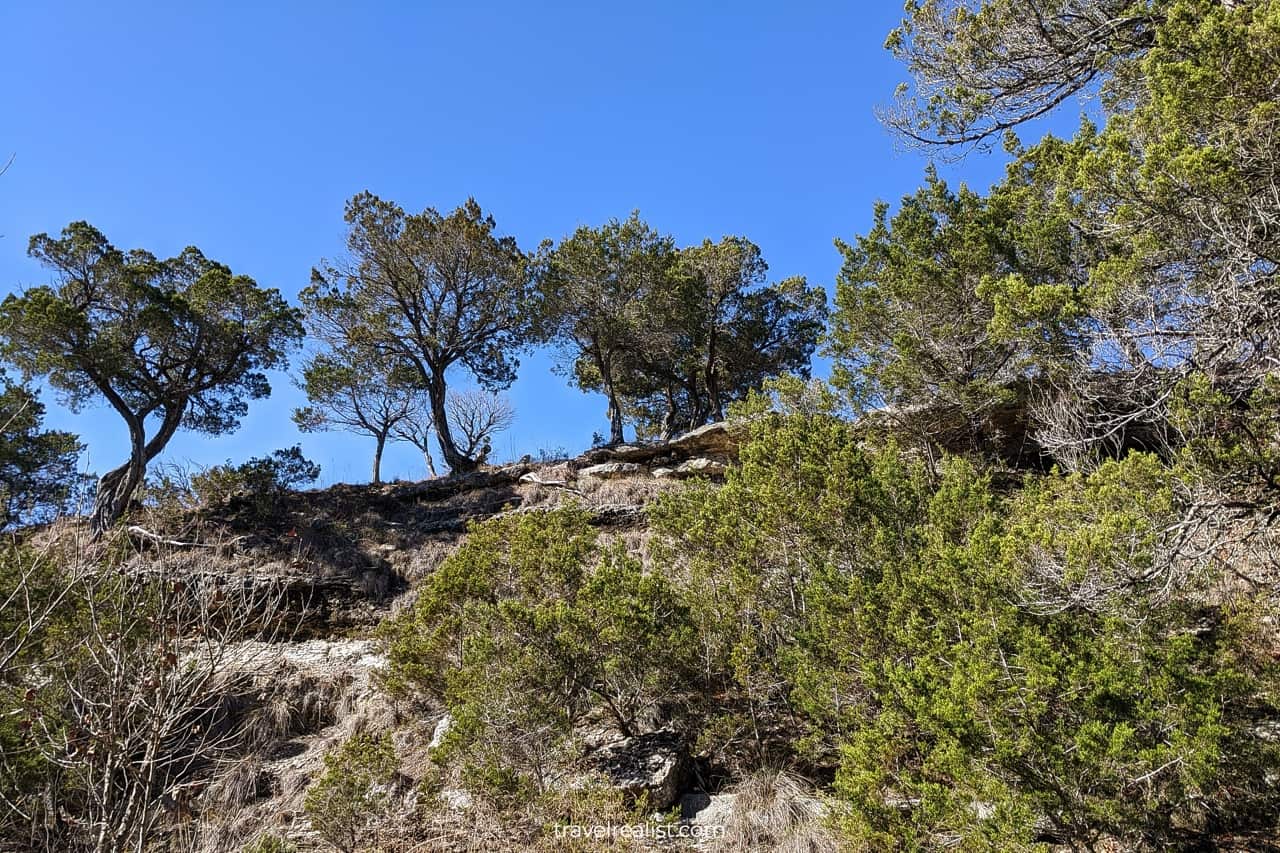
Continue with this Balcones Canyonlands Visitor Guide. You will learn more about ways to get to the sights, entrance requirements, and places to stay.
Getting to Balcones Canyonlands
Balcones Canyonlands National Wildlife Refuge is in a scenic part of the Texas Hill Country. The refuge is just outside of Austin, Texas.
It is west of Cedar Park, south of Bertram, and east of Marble Falls. Lake Travis on the Colorado River is the southern boundary of Balcones Canyonlands.
While the preserve takes up a large area, most of it is not open to the public. There is a clear reasoning behind it. Balcones Canyonlands is there to protect the natural habitat of birds and other wildlife.
Only a few areas are open for recreation. This creates a challenge when visiting the park. If you drive to Balcones Canyonlands using Google Maps, you will find yourself on a beaten-up country road.
There is no visitor center, trailheads, or viewpoints at this location. Instead, you need to enter different addresses to reach day use areas of Balcones Canyonlands:
- Shin Oak Observation Deck: 1929 Ranch to Market Rd 1869, Bertram, TX 78605.
- Doeskin Ranch: 10645 FM 1174, Bertram, TX 78605.
- Warbler Vista: 21646 ½ E. FM 1431 Lago Vista, TX 78654.
- Visitor Information Center: 24518 RM 1431, Marble Falls, TX 78654.
With the right addresses, you are ready to start exploring the park. Despite being close to the city, the refuge is in a remote area. You need a car to get to the preserve and travel between its units.
But proximity to a large metro area has its benefits. Out-of-state visitors could fly to Austin Airport to visit Balcones Canyonlands. This airport has a growing number of direct flights.
You could be hiking at Doeskin Ranch less than an hour after leaving the airport. Highway US-183 has a few toll sections in Austin and Cedar Park. The trip is at least 15 minutes longer if you avoid tolls.
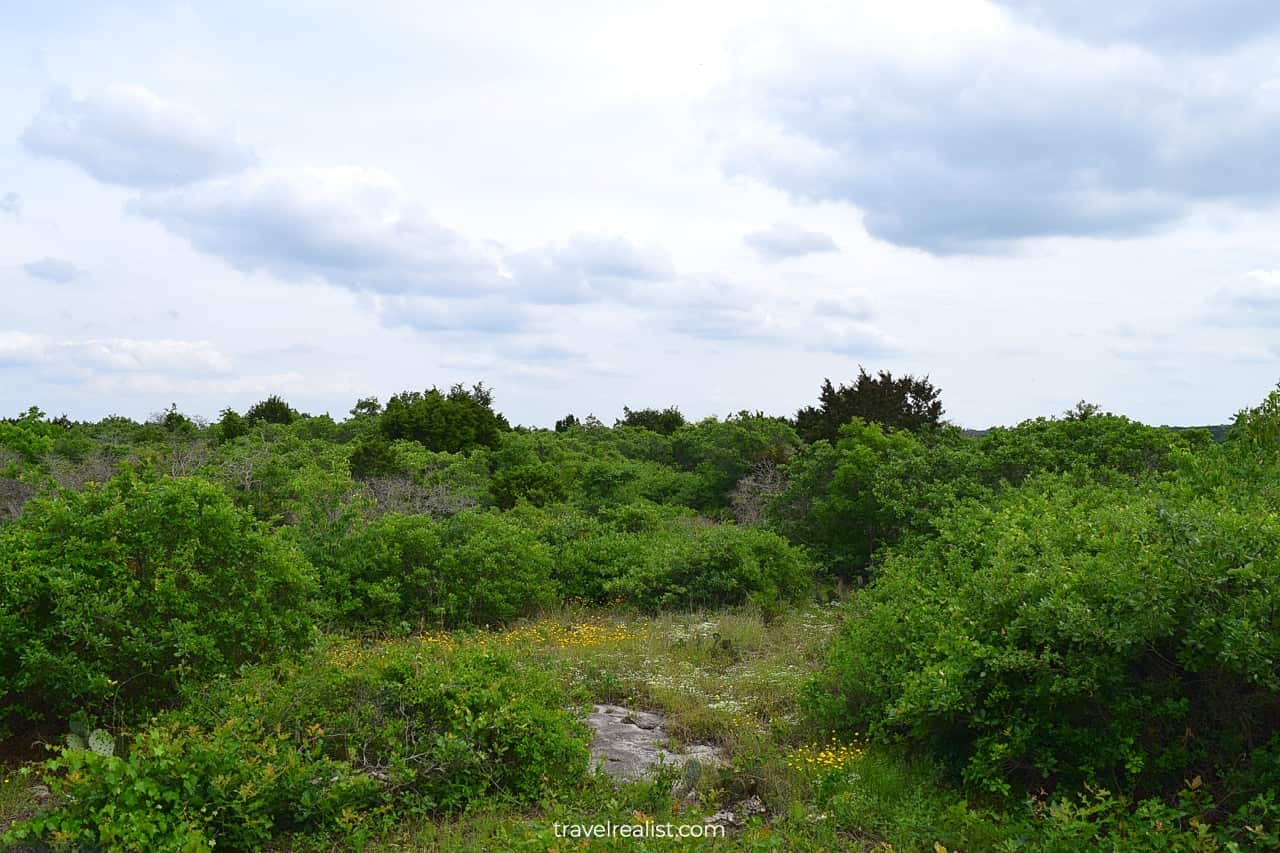
Where to Stay near Balcones Canyonlands
Balcones Canyonlands National Wildlife Refuge is one of the nearest parks to the Austin Metro Area. It certainly helps when looking for a place to stay.
Even better, you do not have to drive all the way to Austin to find a hotel. There are plenty of options in Leander and Cedar Park. They is better if the road takes you next to Longhorn Cavern or Colorado Bend.
Check out Holiday Inn Express & Suites Leander, an IHG Hotel and Hampton Inn & Suites Cedar Park North Austin, Tx. Both are great options near Balcones Canyonlands.
If you drive south, do not overlook Aloft Austin Northwest and Towneplace Suites By Marriott Austin North/Lakeline. A similar advice is true for SpringHill Suites by Marriott Austin Northwest Research Blvd.
The Domain area has a lot of places to stay and dine. You could choose from more luxurious options and midrange hotels. Archer Hotel Austin and Element Austin at The Domain are on the pricier side.
Hilton Garden Inn Austin North-Near the Domain, TX and Residence Inn by Marriott Austin Northwest/The Domain Area are more affordable.
Staying in the Domain could help you beat the traffic if you visit Balcones Canyonlands on a weekday. This observation gives Austin a potential edge over Cedar Park and Leander.
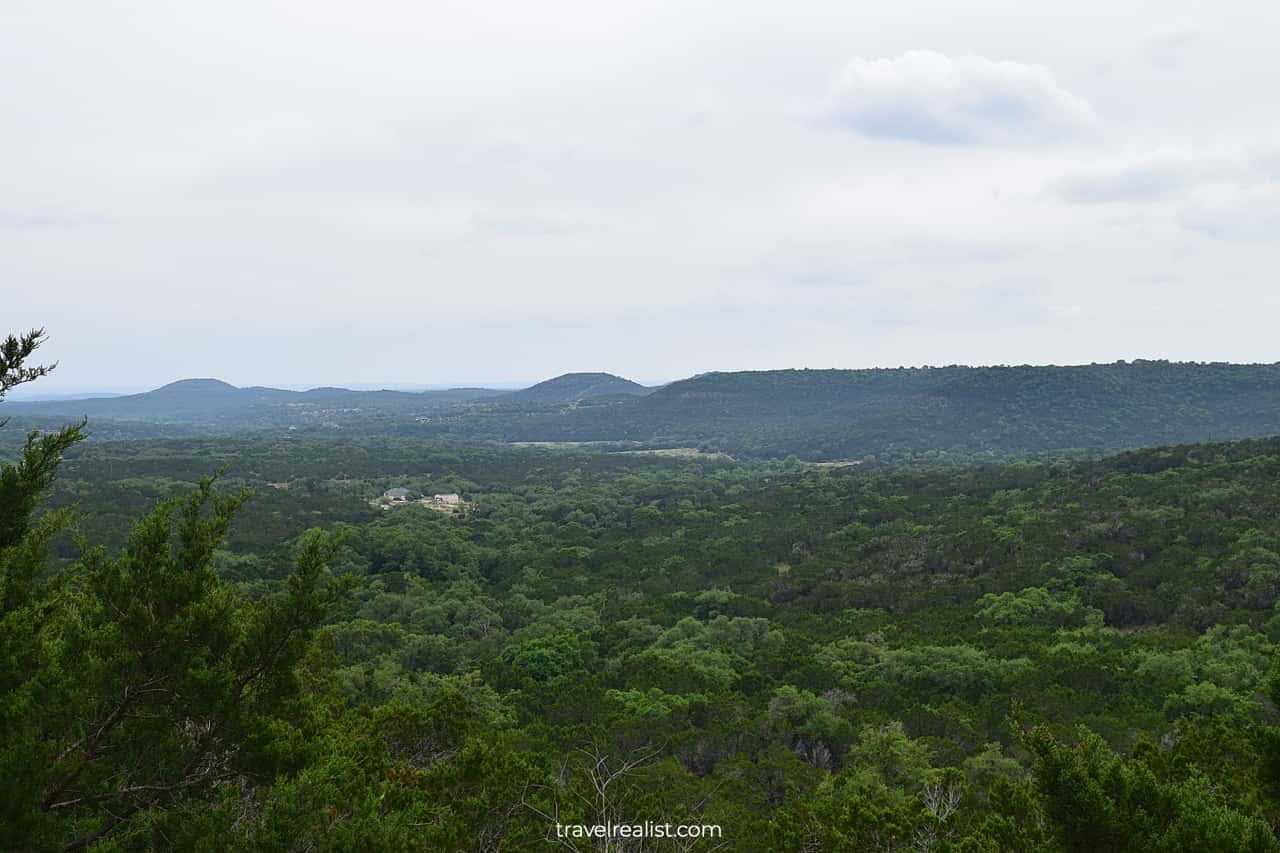
Entrance Requirements & Passes
Balcones Canyonlands National Wildlife Refuge focuses on protecting local plants and wildlife. Some preserves do not open their doors to the public at all. Thankfully, Balcones Canyonlands is different.
While most areas are off limits, you could still visit this preserve year round. You should head to Doeskin Ranch or stop by Warbler Vista and Shin Oak Observation Decks.
All these units are open to visitors from sunrise to sunset. There is no fee to visit the refuge. No worries if you did not take your America the Beautiful annual pass. Save it for other federal lands and parks.
Doeskin Ranch and Warbler Vista have a few hiking trails. But you could only enjoy them on foot. You should leave your pets and bikes at home.
Do not expect to get an advice from a ranger if you visit Balcones Canyonlands on a weekend. The Headquarters and Visitor Information Center are open from 8 a.m. to 4:30 p.m. Monday to Friday.
It means that you have to do your own research before heading to Balcones Canyonlands. The park page covers the key points. This Balcones Canyonlands Visitor Guide fills in the blanks.
You will not be completely without guidance on the ground. There is a large trail map and signs at Doeskin Ranch. But it helps to download offline maps ahead of time to stay on track while hiking.
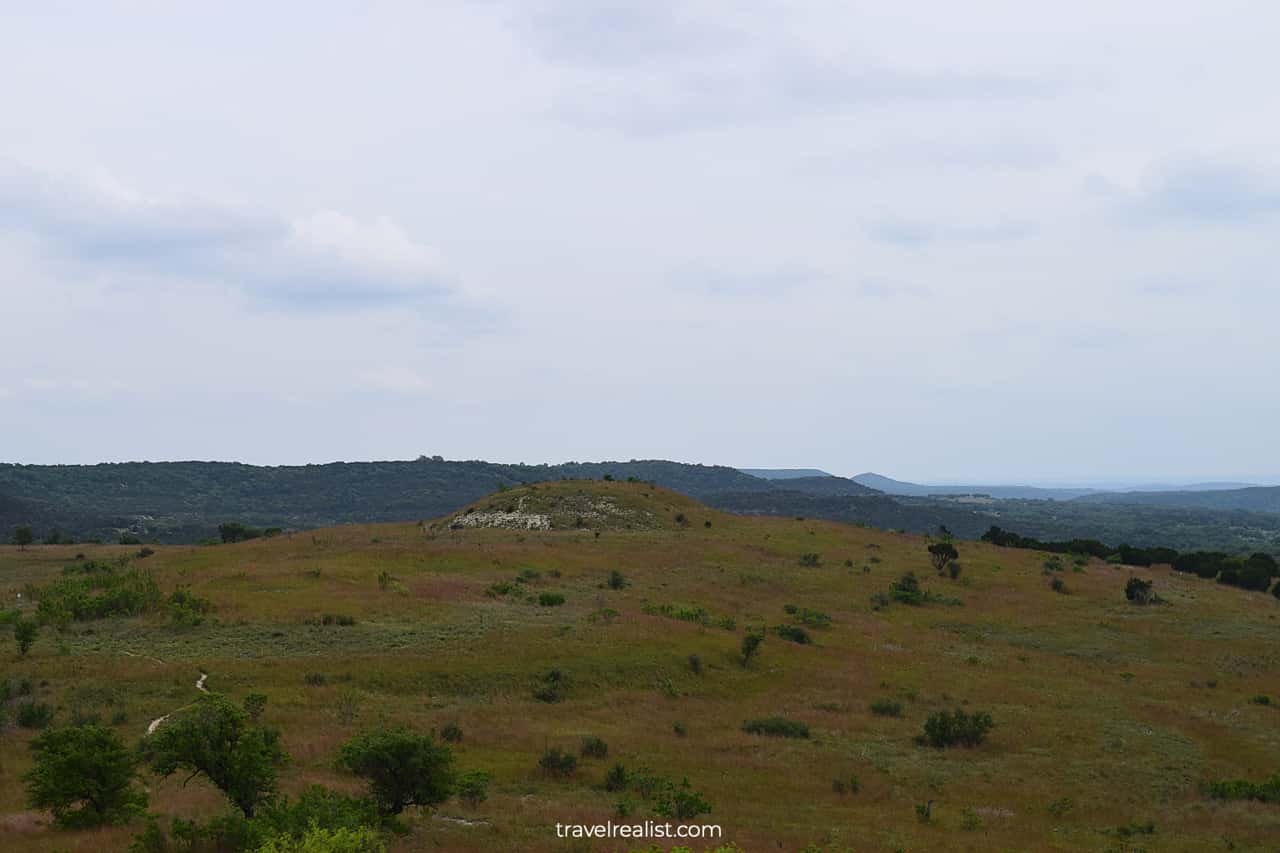
Takeaways: Balcones Canyonlands
Balcones Canyonlands National Wildlife Refuge is a scenic park. The preserve is in a very close proximity to Austin, Texas. It is well worth a visit if you find yourself in Central Texas.
A peaceful experience with nature is a given at Balcones Canyonlands. You could try your luck spotting birds and wildlife at Warbler Vista, Shin Oak, and Doeskin Ranch.
But there are also a few downsides to visiting Balcones Canyonlands. The Visitor Information Center is only open on weekdays. You cannot bike or bring pets to the preserve.
There are just a handful of trails. Most of them are short and not very challenging. The Rimrock, Boulder, and Quarry Canyon Trails are the only exceptions.
If this restrictions sound like dealbreakers, you might enjoy other Central Texas parks more. If you are looking for alternatives to Balcones Canyonlands, check out McKinney Falls and Pedernales Falls.
Take a look at this Balcones Canyonlands Visitor Video Guide. And visit the YouTube channel for the latest videos.
Frequently Asked Questions
Balcones Canyonlands is a National Wildlife Refuge. Recreation is a bit of an afterthought in this preserve. Still, there are a few things you could do at Balcones Canyonlands:
– Go bird watching at Shin Oak Observation Deck.
– Hike the Rimrock Trail to the top of the plateau at Doeskin Ranch.
– Observe nature recovering from a wildfire on the Indiangrass Trail.
– Cross the creek on the Creek Trail.
– Enjoy wildflowers on the Pollinator Path.
– See the Colorado River and Lake Travis from the Sunset Deck.
– Hike the Ridgeline Trail and the Cactus Rock Trail.
Balcones Canyonlands National Wildlife Refuge is in Central Texas. Do not confuse this preserve with Canyonlands National Park in Utah. These two parks could not be more different.
Balcones Canyonlands is a preserve in Central Texas. The refuge is in the Hill Country about an hour northwest of Austin, Texas.
Doeskin Ranch, Shin Oak, and Warbler Vista at Balcones Canyonlands are open every day from sunrise to sunset. But you could only visit the Headquarters from 8 a.m. to 4:30 p.m. Monday through Friday.
You cannot bring dogs and other pets to Balcones Canyonlands. This rule has to do the refuge’s focus on protecting plants and wildlife from human activity and non native species.
No trail in Balcones Canyonlands National Wildlife Refuge allows bikes. You could only explore this preserve by hiking its trails.
Cedar Park and Leander are the nearest cities to Balcones Canyonlands. Check out Hampton Inn & Suites Cedar Park North Austin, Tx and Holiday Inn Express & Suites Leander, an IHG Hotel.
Safe realist travels!


